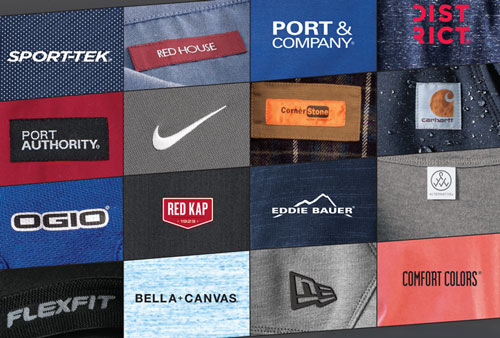Branded Clothing Essentials: Understanding the Fabric Behind the Fashion
Branded Clothing Essentials: Understanding the Fabric Behind the Fashion
Blog Article
The Relevance of Sustainable Garments: Exactly How It Affects the Atmosphere and Your Storage room
Sustainable clothes is progressively recognized for its crucial role in reducing the environmental influence of the quick style sector. By focusing on eco-friendly materials and moral production methods, it deals with pressing environmental problems. This shift not only benefits the planet however additionally influences customer selections, causing an extra thoughtful technique to closet administration. Recognizing these dynamics increases necessary concerns regarding style's future and individual obligation in forming it.
The Ecological Impact of Rapid Style

Benefits of Sustainable Materials
Lasting materials use substantial advantages, especially through environment-friendly fabric selections that minimize ecological injury. These products also demonstrate sturdiness and longevity, decreasing the requirement for frequent replacements. As a result, they add to a much more lasting fashion sector and advertise responsible consumer actions.
Eco-Friendly Material Choices
While the apparel industry has actually long been related to rapid patterns and environmental injury, the rise of environmentally friendly fabric selections offers a transformative chance. Lasting products such as natural cotton, hemp, and Tencel have actually gotten appeal as a result of their reduced eco-friendly impact. These textiles are usually generated without unsafe pesticides and call for less water, decreasing their carbon impact - Branded Clothing. In addition, many environmentally friendly materials are biodegradable, adding to a round economic climate by reducing waste. Selecting lasting materials not only supports environmentally liable methods but likewise promotes healthier environments. As consumers come to be extra knowledgeable about their acquiring power, the demand for green fabrics urges brands to innovate and embrace more lasting production techniques, inevitably benefiting the earth and future generations
Longevity and Long Life Benefits
Several customers are significantly recognizing the resilience and durability benefits of sustainable materials in their garments selections. Unlike standard fabrics, sustainable materials such as organic cotton, hemp, and recycled polyester are engineered to withstand deterioration, resulting in garments that last longer. This minimized frequency of replacement not only conserves consumers money in time however also reduces waste generated by fast fashion. On top of that, lasting clothing often employs environmentally friendly production techniques that improve textile toughness, adding to a reduction in the general carbon footprint. By purchasing long lasting apparel, customers can cultivate a much more lasting closet while enjoying top quality items that preserve their visual and performance in time. Consequently, resilience and long life stand as key advantages of picking sustainable materials.
Reducing Waste Via Lasting Practices
Lowering waste in the garment industry can be achieved with innovative techniques such as upcycling and repurposing materials. Additionally, adopting minimal closet techniques encourages customers to focus on top quality over quantity, ultimately reducing clothes intake. Together, these techniques add substantially to an extra lasting garments model.
Upcycling and Repurposing Materials
Upcycling and repurposing products have actually become cutting-edge strategies in the fashion business, transforming thrown out fabrics right into useful brand-new items. This approach not just reduces waste however likewise urges creative thinking and uniqueness in clothes layout. By taking old garments and materials, developers can create unique items that show individual design while minimizing the demand for new sources. Additionally, upcycling commonly calls for less power and water compared to typical production procedures, considerably decreasing the environmental footprint of style. As customers end up being a lot more mindful of sustainability, the popularity of upcycled garments remains to climb, promoting a round economy. Eventually, these practices contribute to a more sustainable future, where style focuses on environmental health over fast manufacturing and intake.

Minimal Wardrobe Approaches
As people progressively look for to reduce their environmental impact, adopting minimalist closet strategies has actually obtained traction as an effective strategy to lasting style. These methods highlight quality over amount, motivating customers to curate a smaller sized collection of functional, resilient apparel. By concentrating on classic items that can be mixed and matched, individuals can reduce the frequency of acquisitions and eventually lower waste.Additionally, minimalism promotes mindful usage, prompting customers to review the honest and environmental implications of their choices. This strategy not only fosters an extra lasting way of life yet additionally simplifies everyday decision-making concerning clothing. As individuals welcome minimalist concepts, they contribute to a fashion culture that values sustainability and accountable consumerism, inevitably leading to a more eco-conscious culture.
The Duty of Honest Labor in Sustainable Style
While many customers are significantly familiar with the environmental repercussions of their apparel selections, the significance of honest labor techniques in lasting fashion can not be forgotten. Ethical labor incorporates reasonable wages, safe working problems, and respect for workers' civil liberties, creating the backbone of accountable fashion manufacturing. Brand names that prioritize honest labor not only boost areas but also set a standard for accountability in the industry.Moreover, the integration of ethical practices cultivates transparency, making it possible for customers to make informed options about their acquisitions. This method contrasts sharply with quick fashion's exploitative labor models, which typically prioritize revenue over people. By sustaining firms devoted to moral labor, customers add to a system that values human self-respect together with ecological sustainability. As a result, honest labor is not merely an add-on; it is necessary to the broader goal of lasting fashion, making certain that the pursuit for eco-friendliness does not come with the expense of human legal rights.
The Effect of Lasting Garments on Carbon Emissions
Sustainable apparel has the possible to greatly reduce Visit Website carbon exhausts connected with the fashion business. Typical garment manufacturing adds especially to greenhouse gas exhausts, largely as a result of energy-intensive production processes and using non-renewable resources. In contrast, lasting fashion concentrates on environmentally friendly materials, such as organic cotton or recycled fibers, which often need less energy to produce.Moreover, lasting brand names tend to adopt more reliable production techniques, minimizing waste and lowering total discharges. By focusing on sturdiness and timeless style, sustainable garments urges customers to buy less regularly, additional decreasing the carbon footprint connected with overconsumption.Additionally, lots of lasting brands are dedicated to openness in their supply chains, allowing consumers to make educated options that line up with their values. Ultimately, changing towards lasting garments can result useful link in a significant reduction in carbon emissions, adding to a healthier earth and a much more sustainable future for the fashion business.
Sustaining Local Economies With Sustainable Options
The change towards sustainable clothes not just addresses ecological issues however likewise substantially advantages local economic situations. By picking sustainable fashion, consumers frequently support little services and regional artisans, improving community durability. These business generally run on a smaller sized scale, focusing on workmanship and moral practices over mass production.Investing in locally made sustainable garments promotes task creation and boosts financial development within neighborhoods. As consumers become more familiar with the ecological impact of their acquisitions, they increasingly seek out items that mirror their worths. This need encourages neighborhood manufacturers to embrace sustainable techniques, contributing to a round economy.Moreover, supporting neighborhood organizations lowers transportation emissions, aligning with eco-conscious consumer behavior. The interconnectedness of sustainable garments and neighborhood economic situations highlights the crucial role that private options play in advertising both environmental and economic health and wellness. By promoting these regional connections, neighborhoods can thrive while also working in the direction of an extra lasting future.
Changing Your Storage Room: Tips for a Lasting Closet
As people seek to minimize their ecological influence, transforming a wardrobe into a sustainable wardrobe ends up being a necessary action. One efficient technique is to assess existing garments, maintaining only things that are put on frequently and that straighten with sustainability objectives. Prioritizing top quality over amount is crucial; spending in long lasting pieces from environment-friendly brand names can greatly reduce waste.Additionally, integrating second-hand items can rejuvenate a wardrobe while reducing environmental damage. Organizing clothes swaps with close friends or giving away unused products can further promote sustainability.When buying, people need to seek materials that are organic, recycled, or eco-friendly, and avoid rapid style stores - Branded Clothing. Practicing conscious consumption by thoughtfully considering each purchase can contribute to a much more lasting way of life. By applying these ideas, one can produce a wardrobe that shows individual style while sustaining ecological stewardship
Frequently Asked Inquiries
Just How Can I Recognize Lasting Apparel Brands?
To determine sustainable clothes brand names, one ought to investigate like this products made use of, look for qualifications like Fair Trade, and analyze the brand name's transparency regarding their manufacturing procedures, labor techniques, and environmental influence, ensuring environment-friendly and moral practices are focused on.
What Are the Expenses Connected With Sustainable Fashion?
The costs related to lasting fashion can differ considerably. Higher production costs, ethical sourcing, and environmentally friendly products often cause increased retail prices, which may hinder some customers while interesting environmentally aware customers.
Can Sustainable Apparel Be Trendy and elegant?
Sustainable garments can certainly be fashionable and stylish. Designers significantly prioritize innovative products and moral production approaches, showing that style and sustainability can exist together. Customers currently have diverse alternatives that blend aesthetic appeals with environmental consciousness.
Exactly How Does Laundering Clothes Affect Their Sustainability?
Washing garments substantially impacts sustainability by consuming water and energy, adding to contamination, and causing microplastic release. Regular cleaning can weaken textiles, reducing their life expectancy and increasing the requirement for substitutes, eventually exacerbating ecological problems.
What Is the Life Expectancy of Lasting Clothing Contrasted to Fast Fashion?
The life-span of lasting apparel typically exceeds that of rapid fashion products, often lasting a number of years due to quality materials and workmanship. On the other hand, rapid fashion garments might degrade quickly, requiring more frequent replacements. Sustainable garments is significantly recognized for its essential role in lessening the ecological effect of the fast style market. While numerous customers are increasingly mindful of the environmental repercussions of their garments choices, the value of ethical labor methods in sustainable style can not be forgotten. Branded Clothing. Lasting clothing has the possible to significantly decrease carbon exhausts linked with the fashion industry. In contrast, lasting style focuses on green products, such as organic cotton or recycled fibers, which commonly require less power to produce.Moreover, sustainable brand names tend to adopt a lot more efficient manufacturing practices, lessening waste and lowering overall exhausts. By prioritizing resilience and timeless layout, lasting clothes motivates customers to get much less regularly, more lowering the carbon impact connected with overconsumption.Additionally, lots of sustainable brands are dedicated to openness in their supply chains, making it possible for customers to make informed selections that line up with their worths
Report this page